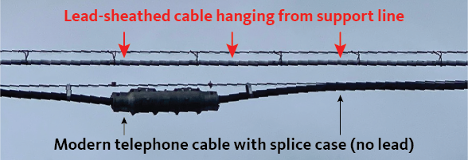
What Happened
A blockbuster Wall Street Journal (WSJ) investigation in July 2023 reported that lead-sheathed telecom cables release lead into water or surface soil, drawing significant attention to this previously overlooked source of environmental contamination. These cables are essentially lead pipes filled with copper telephone wires. In March 2024, Caravanos et al. confirmed these findings in Louisiana, New Jersey, New York, and Pennsylvania, concluding that the “elevated levels of lead in soil tended to be localized within a radius of a few feet” from the cables. The telecom giant, AT&T, asserts that “there’s no nationwide public health risk.”
An impressive new study by Alyssa Shiel and her team at Oregon State University extends those studies by showing lead-sheathed cables are a likely source of new lead contamination that adds to the overall burden associated with these cables accumulated over the decades. Shiel’s team used radioisotope analysis in urban moss samples collected in 2013 and 2023 to distinguish between the contribution the telecom cables and leaded gasoline. Because this urban moss grows in trees and receives all its moisture, nutrients, and metals from the air, precipitation, and dust, it is helpful to assess the reach of metal emissions as well as changes over time. Each sample of moss is thought to “represent accumulation over several months to a maximum of three years.”
The researchers found the highest lead levels, up to 590 times the rural background, in older residential neighborhoods where relic lead-sheathed telecommunication cables were found. This compares to 19 times higher level in these neighborhoods that they attributed primarily to leaded gasoline. They found that the levels persist in moss 10 years after removal of the cables as the lead moves through the environment. While the study was done in Portland, Oregon, the findings are applicable broadly to anywhere the lead-sheathed telecom cables are found overhead.
Shiel and her team also created an excellent webpage where the public can learn how to distinguish between utility and telecom cables and fiber optic and coaxial cables from the older lead-sheathed telecom cables.
Why it Matters
With no safe level of lead exposure, evidence that lead migrates from the telecom cables into the environment is significant because there are an estimated 90,000 miles of these cables—many of which have been abandoned in place—hanging from utility poles or laying on the bottom of rivers, lakes, and streams.1
To adequately assess the risk, communities and regulators need rigorous, independent evaluations of the lead migration from the cable. The innovative study and online tools by Shiel and her team are important building blocks toward that goal.
EPA’s Investigation
In response to the Wall Street Journal articles and a request from three organizations, last year EPA investigated contamination and published detailed findings in West Orange, New Jersey, Coal Center and California, Pennsylvania, and seven parishes in Louisiana (which includes an engaging story map). In each, they identified high levels of lead in some soil samples that may have been associated with the cables but found no immediate threats to the health of people nearby, primarily based on the presence of grass as a natural barrier or lack of evidence that children gather for long periods of time in the area.
However, EPA’s analysis used 400 parts per million in soil as a screening threshold. In January, EPA lowered those levels to 100 ppm where other lead may be present or 200 ppm where soil is the only source.
Recognizing that these cables are present in thousands of communities in the United States, the agency has been meeting with telecom companies to gather more information and convened a national working group to “better understand if the cables have released and continue to release lead.” However, no further information is publicly available.
Lacking action from EPA, one parish and two south Louisiana cities filed a class action lawsuit in July against two telecom companies claiming the deteriorated lead-sheathed cables are causing severe environmental damage. In addition, a lawsuit over 6 miles of abandoned lead-sheathed telecom cables on the floor of Lake Tahoe in California remains unresolved.
Our Take
The evidence from EPA and Caravanos et al. make a strong case for action. Shiel and her team’s evidence that that the lead-sheathed telecom cables continue to release lead in the environment makes the need for action compelling.
We have heard various rationales for leaving them in place such as potentially reconnecting them in an emergency, keeping their easement active, or avoiding releasing more lead by disturbing them. But it rings false. They are essentially leaving their toxic waste in neighborhoods. The residents—who usually are the telecom company’s customers—deserve better.
Based on what is known, we think that
- Abandoned lead-sheathed telecom cables hanging from utility poles must be removed in a safe manner.
- Where the abandoned cables are in the water, they should be removed—carefully—to present the spread of contaminated sediment around them.
- Where they are not abandoned, the companies and the regulators responsible for protecting them need a serious program that effectively engages impacted communities to manage the risk until the lines are replaced. And that replacement needs to happen.
Finally, we need the companies to be transparent about the specific location of the lead-sheathed cables. In New York, Verizon went to court to block the Public Service Commission from releasing even the total miles of the cables in the state, claiming the information is a trade secret that “could shed light on Verizon’s potential exposure to remediation costs, an important, and competitively relevant, financial parameter concerning its operations.” The Commission is appealing the courts injunction.
Until they do, people should use the tool that Shiel’s team provides to check their neighborhood for aerial lead-sheathed telecom cables.
Next Steps
EPA needs to finalize its assessment of the risk and take action.
We also would like to take this opportunity to invite YOU to take action. Look up as you are exploring your neighborhoods or those neighborhoods where you are vacationing. Snap a photo and tag Unleaded Kids on LinkedIn, X (formerly Twitter), or Instagram—or email your photos to tneltner@unleadedkids.org.
- In a July 2023 court filing, AT&T said that “[b]ased on its records, AT&T estimates that lead-clad cables represent less than 10% of its copper footprint of roughly two million sheath miles of cable, the overwhelming majority of which remains in active service. More than two thirds of its lead-clad cabling is either buried or in conduit, followed by aerial cable, and with a very small portion running underwater.” This is roughly 66,000 miles (2,000,000*10%*33%). Verizon said it has 540,000 of cable and that less than 15% was lead-sheathed cables. Assuming 1/3 were aerial or submerged, this is about 27,000 miles. The total from these two major telecom companies is 93,000 miles. We rounded down to 90,000. ↩︎
